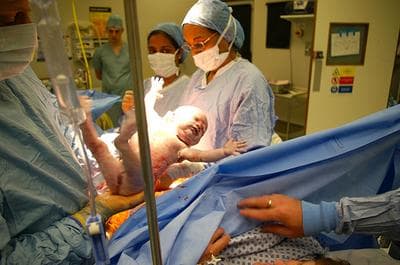Advertisement
Will The C-Section Rate Soon Hit 50 Percent?

Pretty much everyone agrees that the number of cesarean deliveries in the U.S. is too high: the rate has soared from 6% in the 1960s to 32% today.
In a recent editorial in the medical journal Obstetrics and Gynecology, Deputy Editor Dr. John Queenan suggests that we have yet to reach the peak. "The rate is likely to exceed 50% very soon in the U.S.," he writes. "How can we curtail this runaway increase in cesarean deliveries?"
What's really troubling, says Queenan, Professor and Chair emeritus at Georgetown University’s Department of Obstetrics and Gynecology, is that almost one-third of C-sections are for women who are having their first child, and that sets up a vicious cycle of future surgeries since vaginal births after cesareans (VBACs) are decreasing — some hospitals won't even do them.
It didn't used to be this way. In the past, C-sections required a prior consultation and full department review. Now, scheduled c-sections are often done at the patient's request and vaginal delivery of breech babies "is no longer taught in many training programs," he writes.
Of course, C-sections are safer now, but they are also more profitable for hospitals than normal, vaginal deliveries, and for doctors, they can be more efficient from a time-management perspective.
Nevertheless, if the numbers continue upward, Queenan says, "our profession will lose both credibility and the opportunity to determine our direction as third-party payers and the government will become involved."
He offers a few suggestions to fix the problem:
1. A commitment from hospital obstetric departments to lower the c-section rate (this might also involve fewer labor inductions, which can also lead, inexorably, to surgical birth).
2. Better patient education so they are more fully aware of the risks and benefits of their choices.
3. Tort reform, so that ob/gyns don't resort to C-sections as frequently "if any element of risk arises."
4. Use more nurse midwives, whose "motivation to achieve vaginal delivery would be stronger."
5. Provide equal compensation for vaginal and C-section births; compensate VBAC's at a higher rate than normal delivery
6. Re-establish teaching and training for breech deliveries
Readers, childbirth experts, moms, do you have any other suggestions for this list?
This program aired on October 4, 2011. The audio for this program is not available.
